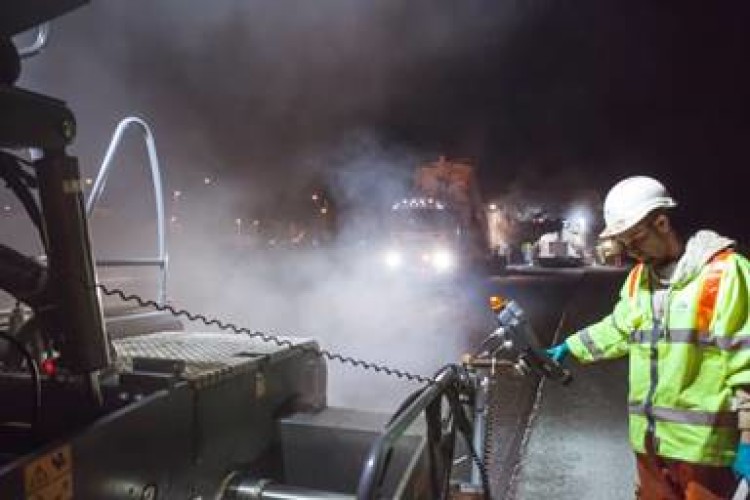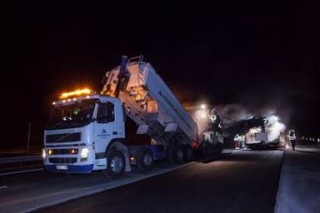The trial was undertaken on the southbound carriageway of the M6 between junctions 36, Burton to Cinderbarrow on the 27th and 28th July 2016. But news of the experiment was kept under wraps for four months.
Though the method is widely used in Germany and elsewhere, UK contractors have been slow to adopt hot-on-hot paving (also known as inline paving). It is an equipment intensive method that lays the binder course and surface course in a single pass, forming a fully homogenous layer.
The binder course layer is compacted with a high compaction screed giving full compaction throughout the layer. The surface course material is laid directly behind using a transfer vehicle to feed the material into the paver; this is then compacted as normal using standard equipment.
For the Highways England trial, the original specification was for 60mm of binder course and 40mm of surface course, by using the hot-on-hot system the material thicknesses where changed to 70mm of binder course and 30mm of surface course.
The development of hot-on-hot compact asphalt pavement technology began in Germany back in 1996. It was led by Dynapac (now part of the Atlas Copco group) under the supervision of Dr Elk Richter of the University of Applied Sciences in Erfurt. It took many years of trials to persuade German highway authorities that what worked in a laboratory would work on real roads and would provide a durable road surface.
Any questions about the quality of results obtained seemed to have been effectively answered. A study by the University of Darmstadt has confirmed the performance of a 12-year-old Compactasphalt highway in Germany. A group of Lithuanian highway engineers also carried out an in-depth study of the two systems on visits to Germany in 2007 and 2008 for the Baltic Road Association and came away impressed.
Their independent report states: “By using compact asphalt pavements the following objectives are achieved: better compaction conditions; high bonding and interlocking of two courses, which also guarantees the resistance of surface course to shear stresses and deformations; reduced thickness of surface course saves the high quality and expensive aggregates, which have high polished stone value (PSV) and high retroreflection characteristics.”

Advantages
The advantages of the hot-on-hot method can be summarised as:
Extended paving period: Paving can be carried out in temperatures down to down to 0°C/32°F, which significantly extends the paving season.
Material saving: Half the amount of expensive top course is required and there is no bitumen emulsion (tack) needed between the courses. The required thickness of the surface course of asphalt is reduced from 400mm to 250mm or 150mm. The thinner top layer also allows the cost-effective use of high-value mineral nutrients for polishing resistance, elucidation and edge strength.
Time saving: As two courses are paved in a single pass, it is quicker. In Germany it seems to be precisely twice as quick.
Quality: It also seems that the improved interlocking of the courses results in a more durable surface that is less prone to rutting.
All of this implies, of course, not only significant cost savings (life-cycle costs saving of more than 20€/m2 in Germany) but also less disruption to road traffic because it is quicker.
There is a more detailed report on UK attitudes to the hot on hot method of laying asphalt in the June 2013 issue of The Construction Index magazine. Click on http://epublishing.theconstructionindex.co.uk/magazine/june2013 and scroll to page 29.
Got a story? Email news@theconstructionindex.co.uk




